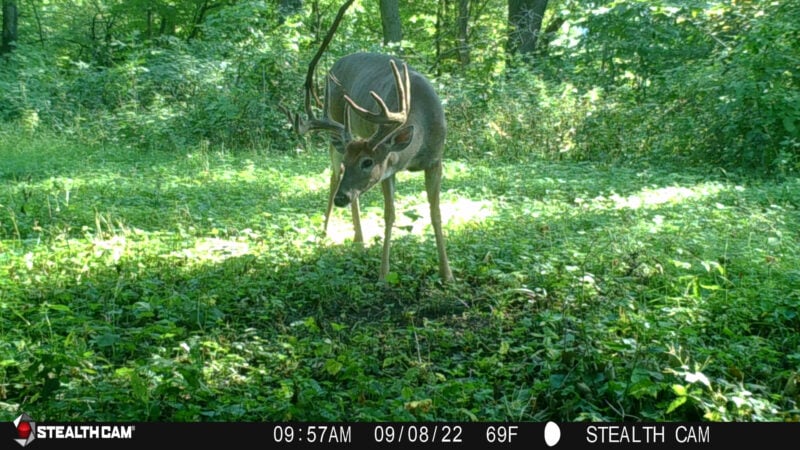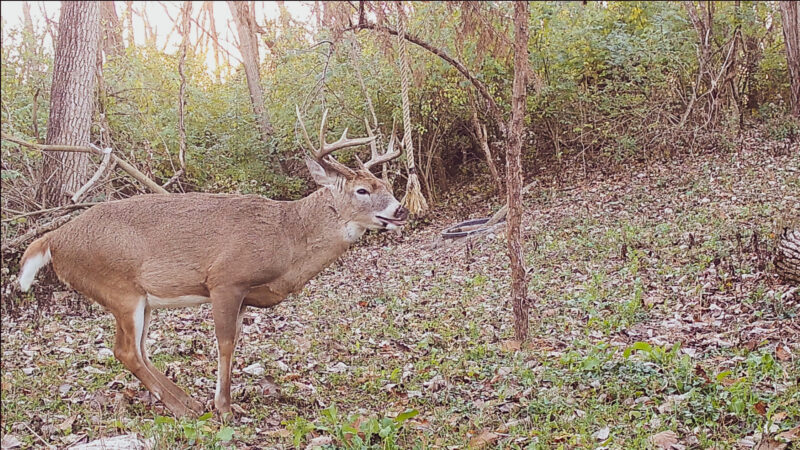Mock scrapes have been all the rage for a number of years now, and for good reason. Mock scrapes are a great tool for any hunter to have in their toolbox, but unfortunately many users are less than pleased with the results that mock scrapes have produced for them.
These lack luster results are normally caused because of misinformation on how scrapes truly work, as well as not using mock scrapes to their full potential. In this article, I will discuss how scrapes really get used and debunk some of the myths about them.
I will then cover the many uses of mock scrapes, and why they are such a fantastic tool, especially for the bowhunter. Lastly, I will cover how and where I create mocks scrapes, and what I specifically do that I feel sets my methods apart from most other mock scrape users.

The Truth About Scrapes
There has been a tremendous amount of research done on scrapes to identify how and why deer make and use them. Because of this, I won’t bore you with too much of the technical stuff. Simply put, scrapes are a form of scent communication that deer use to keep tabs on one another in the area.
Scrapes are comprised of two main parts, the overhead branch (the licking branch), and the pawed-out area on the ground (the ground scrape). Deer will deposit scent through a variety of glands to both the licking branch and the ground scrape in order to let other deer know that they are there. It is believed that this scent can potentially identify individual deer, maturity, sex and dominance.
The glands that deposit scent to the licking branch are located on the deer’s head and face, with the most well-known being the pre-orbital and forehead glands. The glands that deposit scent into the ground scrape are located on the deer’s legs and hoofs, with the most well-known being the tarsal gland and the interdigital glands.
Now that we have gone over some of the technical stuff, let’s get into some of the myths about scrapes.
Mock Scrape Myth #1
Scrapes are only used by bucks – Although bucks normally are the ones that make the scrapes and do a good majority of the scraping in the fall, they are not the only deer that utilize scrapes.
Deer of all ages, both does and bucks, will communicate with one another by using scrapes.

Mock Scrape Myth #2
Scrapes are only used during the rut – Nothing could be further from the truth. Scraping activity peaks just prior to peak breeding, but scrapes are used year-round.
One reason this myth exists is because deer don’t normally use the ground scrape portion outside of the rut. The licking branch is what gets the most attention.
With the lack of cleared dirt under the licking branch along with actively growing vegetation, it makes identifying active scrapes much more difficult during spring and summer months.

Mock Scrape Myth #3
The ground scrape is the most important portion of a scrape – Although both components are important, the licking branch is what gets used the most, and gets used year-round.
Without a licking branch, a scrape will eventually stop being used and disappear. You may find a natural scrape without a licking branch, but those are often made by either younger bucks, or out of frustration, and will likely never be used again.
Mock Scrape Uses
Mock scrapes are an extremely versatile tool that can provide a tremendous benefit to all hunters, but especially bowhunters. Below are just a few of the many benefits that mock scrapes can provide.
Attraction – A mock scrape is a great way to attract deer to a specific location. Every one of my stand/blind locations has a mock scrape located near it.
This attraction is especially effective when bucks are cruising during the late pre-rut. It’s like they can’t help themselves from working a well-used scrape if they are in the general area.
This attraction doesn’t have to be limited to a hunting scenario. Here in my home state of Illinois, the use of mineral or supplemental feed is prohibited, so I rely heavily on mock scrapes for taking trail cam inventory of the bucks on my property.

Distraction and Shot Opportunity – Mock scrapes offer the benefit of providing a distraction that grabs the attention of a buck. One of the hardest things about bowhunting is getting drawn back on a buck. But that becomes much easier if that buck has his head stuck in a licking branch or is completely focused on working a mock scrape.
Mock scrapes can also be positioned in a manner to help the hunter get a shot opportunity. As stated before, I have mock scrapes at all of my stand and blind locations, and they are positioned well within bow range to help with getting the best shot opportunity possible.
Rescue Natural Scrapes – One use that I have found for mock scrapes is to rescue natural scrapes that have a dying or dead licking branch. As I mentioned before, without the licking branch, a scrape will eventually stop getting used.
I have one scrape in particular on my property that has been there longer than I have owned the place. That’s over 9 years! Unfortunately, the hedge tree that it is under has seen better days. The licking branch has begun to die, and it keeps getting broken off higher from the ground.
Last spring, I went in and used a length of jute rope and tied it off to a higher branch for the deer to start using in place of the natural licking branch, and it worked like a charm.

Making Mock Scrapes
When it comes to making mock scrapes, location is by far the most important factor. You can’t create a mock scrape where deer don’t want to go and expect to get good results. I focus on areas that already have a relatively high concentration of deer movement such as food plots, pinch points, funnels that lead to and from food and/or bedding, etc.
One of my favorite areas to place mock scrapes is along the downwind side of known doe bedding areas. These locations can be dynamite during the rut when bucks are cruising.
Once you find the right location, there are many ways to make the actual mock scrape. I have used rope, grapevines, existing branches, and even cutting and relocating branches. The key to it is to place them right in the deer’s face and make them stick out.
Even though mock scrapes are for scent communication, the visual appeal is important. If the buck can’t smell it, he needs to see it. I prefer using rope because I have found it to last longer than most other options and it does a great job of holding scent.
I will normally hang a 3’ length of jute or hemp rope that is 1” in diameter, by attaching it to a branch with paracord. Ideally the bottom of the rope should be approximately 48” off the ground, any lower and you run the risk of raccoons trying to hang from it, and any higher, the fawns struggle to reach it without standing on their hind legs.
Once hung, I use a quality pre-orbital scent on the rope. Keep in mind that there are lots of different scents available, and some don’t make sense to use on the rope/licking branch. A urine-based scent such as doe in estrous or buck tarsal scent won’t naturally be found on a licking branch, unless deer stand upside down and pee in the air!

How I Use Mock Scrapes
Alright, now what you have all been waiting for. What is it that I do differently than most when it comes to mock scrapes? Really there are only two things that I feel set me apart from most.
First, I use mock scrapes to encourage buck movement by mimicking what occurs naturally, and that is scrape lines. It’s no secret that bucks will develop scrape lines along their travel routes, so I do the same with my mock scrapes.
This technique is especially effective when designing or making improvements to a property. For example, I created a food plot on my property along the North side of my sanctuary, and the first thing I did after the food plot was completed was to create a mock scrape line leading to and from that food plot.

I created 5 mock scrapes along a +/- 100-yard-long route that ran directly through that food plot, and the bucks have taken it over and actually extended the scrape line each direction. Prior to this, there was never a scrape along that route since owning the property.
Now it is a regular cruising route that has offered many great hunting opportunities as well as some great trail camera photos/videos. I did the same thing on the South side of my sanctuary several years ago and had similar results. That mock scrape line has been the demise of several mature bucks over the years.
The second technique I use is that I keep my mock scrapes going year-round. I don’t take them down or abandon them during the off-season, I will periodically freshen them up with scent so that deer continue to interact with them throughout the spring and summer.
By doing this, I have been able to create annual patterns for bucks that are very consistent. I harvested a great 4-5 year old buck in 2022 as he was coming towards me working the scrape line that I had created.
I had pictures of that buck the year before working those scrapes all through the summer and fall, and that pattern continued into 2022. Unfortunately, I made a poor shot and was unable to recover the buck until some time later.
Conclusion
Mock scrapes are an often-underutilized tool that can produce excellent results if used properly. Don’t be afraid to experiment with them and try new things, you may be surprised at the results.
The key to success with mock scrapes is to mimic nature as closely as possible but place the mock scrapes in a manner that benefit you

 By
By 



